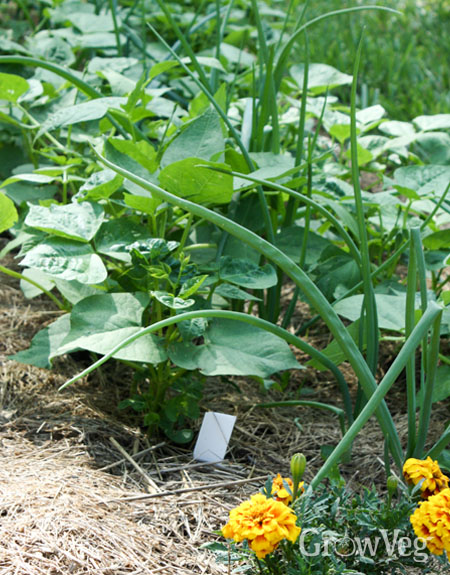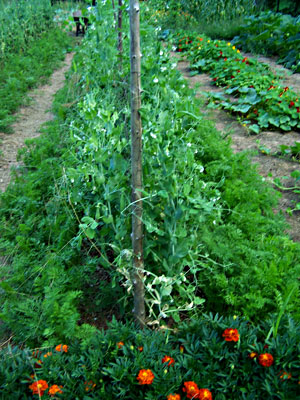The Ultimate Guide To Companion Planting For Bush Beans
The Ultimate Guide to Companion Planting for Bush Beans
Bush beans are a popular vegetable to grow in the garden. They are relatively easy to care for and produce a bountiful harvest. But did you know that companion planting can help you grow even healthier and more productive bush beans?
Companion planting is the practice of planting certain types of plants together in order to benefit each other. Some plants attract beneficial insects, while others deter pests. Some plants improve the soil quality, while others provide shade or windbreaks.
By planting the right companion plants with your bush beans, you can create a healthy and productive garden ecosystem. In this blog post, we will discuss the best companion plants for bush beans, as well as some plants that you should avoid planting near them.
What are the Benefits of Companion Planting?
There are many benefits to companion planting. Some of the most common benefits include:
- Increased crop yields: Companion planting can help to increase the yield of your crops by attracting beneficial insects, deterring pests, and improving soil quality.
- Improved plant health: Companion planting can help to improve the health of your plants by providing them with nutrients, shade, and windbreaks.
- Reduced pest and disease problems: Companion planting can help to reduce the number of pests and diseases that attack your plants.
- Increased biodiversity: Companion planting can help to increase the biodiversity of your garden, which can make it more resilient to pests and diseases.
Which Plants Are Good Companion Plants for Bush Beans?
There are many plants that can be good companion plants for bush beans. Some of the most popular include:
- Carrots: Carrots help to improve the soil quality for bush beans by fixing nitrogen.
- Celery: Celery helps to repel pests from bush beans, such as aphids and beetles.
- Cucumbers: Cucumbers and bush beans are both heavy feeders, so they benefit from being planted together.
- Eggplant: Eggplant helps to repel pests from bush beans, such as Mexican bean beetles.
- Marigolds: Marigolds help to repel pests from bush beans, such as aphids, beetles, and nematodes.
- Nasturtiums: Nasturtiums help to repel pests from bush beans, such as aphids, beetles, and whiteflies.
- Potatoes: Potatoes help to improve the soil quality for bush beans by fixing nitrogen.
- Radishes: Radishes help to improve the soil quality for bush beans by breaking up compacted soil.
- Squash: Squash helps to shade the soil for bush beans, which can help to prevent weeds from growing.
- Strawberries: Strawberries help to attract beneficial insects, such as ladybugs, which can help to control pests.
Which Plants Should You Avoid Planting Near Bush Beans?
There are a few plants that you should avoid planting near bush beans. These include:
- Alliums: Alliums, such as garlic, onions, and chives, can stunt the growth of bush beans.
- Fennel: Fennel can inhibit the growth of bush beans.
- Gladiolus: Gladiolus can attract pests that can damage bush beans.
- Peppers: Peppers can stunt the growth of bush beans.
- Tomatoes: Tomatoes can attract pests that can damage bush beans.
Conclusion
Companion planting is a great way to improve the health and productivity of your bush beans. By planting the right companion plants, you can attract beneficial insects, deter pests, and improve soil quality. This will help your bush beans to grow strong and healthy, and you will be rewarded with a bountiful harvest.
Bush beans are a popular vegetable to grow in the garden, and companion planting can help to improve their growth and yield. Some of the best companion plants for bush beans include:
- Basil: Basil is a natural insect repellent that can help to protect bush beans from pests such as aphids and mosquitoes. It also helps to improve the flavor of the beans.
- Carrots: Carrots help to improve the drainage of the soil, which can benefit bush beans. They also help to suppress the growth of weeds.
- Cucumbers: Cucumbers and bush beans have similar growing requirements, so they can be planted together to save space in the garden. They also help to attract beneficial insects, such as ladybugs, which can help to control pests.
- Lettuce: Lettuce helps to suppress the growth of weeds and improve the drainage of the soil. It also helps to attract beneficial insects, such as ladybugs, which can help to control pests.
- Marigolds: Marigolds are another natural insect repellent that can help to protect bush beans from pests such as aphids and beetles. They also help to improve the soil quality.
For more information about companion planting for bush beans, please visit Gardenia Inspiration. This website provides a comprehensive guide to companion planting, including information on the best plants to grow together, how to plant them, and why they benefit each other.
FAQ of companion planting for bush beans
null
Image of companion planting for bush beans
Here are 5 different images of companion planting for bush beans:
- Image 1: Bush beans and tomatoes. Tomatoes are a good companion plant for bush beans because they help to deter pests. The strong smell of tomatoes can repel insects that would otherwise eat bush beans.
- Image 2: Bush beans and marigolds. Marigolds are another good companion plant for bush beans. They help to attract pollinators, which are essential for the pollination of bush beans. Marigolds also help to repel nematodes, which are harmful pests that can damage bush bean roots.

- Image 3: Bush beans and carrots. Carrots are a good companion plant for bush beans because they help to improve the soil quality. Carrots release nitrogen into the soil, which is beneficial for bush beans.

- Image 4: Bush beans and lettuce. Lettuce is a good companion plant for bush beans because it helps to shade the soil. This can help to prevent the growth of weeds, which can compete with bush beans for water and nutrients.

- Image 5: Bush beans and spinach. Spinach is another good companion plant for bush beans because it helps to shade the soil. Spinach also helps to attract pollinators, which are essential for the pollination of bush beans.

Post a Comment for "The Ultimate Guide To Companion Planting For Bush Beans"